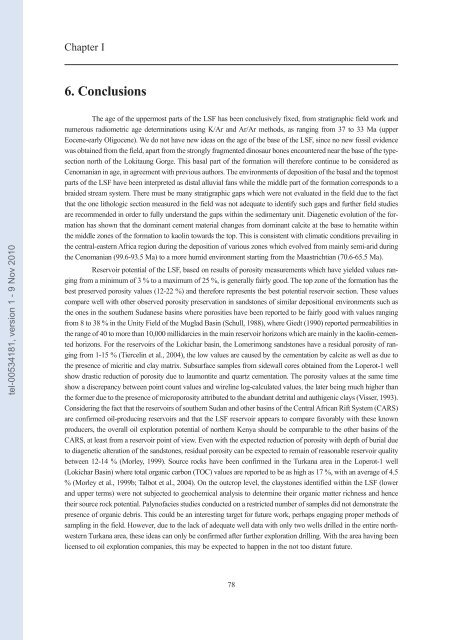Etude stratigraphique, pétrographique et diagénétique des grès d ...
Etude stratigraphique, pétrographique et diagénétique des grès d ...
Etude stratigraphique, pétrographique et diagénétique des grès d ...
Create successful ePaper yourself
Turn your PDF publications into a flip-book with our unique Google optimized e-Paper software.
tel-00534181, version 1 - 9 Nov 2010<br />
Chapter I<br />
6. Conclusions<br />
The age of the uppermost parts of the LSF has been conclusively fixed, from stratigraphic field work and<br />
numerous radiom<strong>et</strong>ric age d<strong>et</strong>erminations using K/Ar and Ar/Ar m<strong>et</strong>hods, as ranging from 37 to 33 Ma (upper<br />
Eocene-early Oligocene). We do not have new ideas on the age of the base of the LSF, since no new fossil evidence<br />
was obtained from the field, apart from the strongly fragmented dinosaur bones encountered near the base of the typesection<br />
north of the Lokitaung Gorge. This basal part of the formation will therefore continue to be considered as<br />
Cenomanian in age, in agreement with previous authors. The environments of deposition of the basal and the topmost<br />
parts of the LSF have been interpr<strong>et</strong>ed as distal alluvial fans while the middle part of the formation corresponds to a<br />
braided stream system. There must be many stratigraphic gaps which were not evaluated in the field due to the fact<br />
that the one lithologic section measured in the field was not adequate to identify such gaps and further field studies<br />
are recommended in order to fully understand the gaps within the sedimentary unit. Diagen<strong>et</strong>ic evolution of the formation<br />
has shown that the dominant cement material changes from dominant calcite at the base to hematite within<br />
the middle zones of the formation to kaolin towards the top. This is consistent with climatic conditions prevailing in<br />
the central-eastern Africa region during the deposition of various zones which evolved from mainly semi-arid during<br />
the Cenomanian (99.6-93.5 Ma) to a more humid environment starting from the Maastrichtian (70.6-65.5 Ma).<br />
Reservoir potential of the LSF, based on results of porosity measurements which have yielded values ranging<br />
from a minimum of 3 % to a maximum of 25 %, is generally fairly good. The top zone of the formation has the<br />
best preserved porosity values (12-22 %) and therefore represents the best potential reservoir section. These values<br />
compare well with other observed porosity preservation in sandstones of similar depositional environments such as<br />
the ones in the southern Sudanese basins where porosities have been reported to be fairly good with values ranging<br />
from 8 to 38 % in the Unity Field of the Muglad Basin (Schull, 1988), where Giedt (1990) reported permeabilities in<br />
the range of 40 to more than 10,000 millidarcies in the main reservoir horizons which are mainly in the kaolin-cemented<br />
horizons. For the reservoirs of the Lokichar basin, the Lomerimong sandstones have a residual porosity of ranging<br />
from 1-15 % (Tiercelin <strong>et</strong> al., 2004), the low values are caused by the cementation by calcite as well as due to<br />
the presence of micritic and clay matrix. Subsurface samples from sidewall cores obtained from the Loperot-1 well<br />
show drastic reduction of porosity due to laumontite and quartz cementation. The porosity values at the same time<br />
show a discrepancy b<strong>et</strong>ween point count values and wireline log-calculated values, the later being much higher than<br />
the former due to the presence of microporosity attributed to the abundant d<strong>et</strong>rital and authigenic clays (Visser, 1993).<br />
Considering the fact that the reservoirs of southern Sudan and other basins of the Central African Rift System (CARS)<br />
are confirmed oil-producing reservoirs and that the LSF reservoir appears to compare favorably with these known<br />
producers, the overall oil exploration potential of northern Kenya should be comparable to the other basins of the<br />
CARS, at least from a reservoir point of view. Even with the expected reduction of porosity with depth of burial due<br />
to diagen<strong>et</strong>ic alteration of the sandstones, residual porosity can be expected to remain of reasonable reservoir quality<br />
b<strong>et</strong>ween 12-14 % (Morley, 1999). Source rocks have been confirmed in the Turkana area in the Loperot-1 well<br />
(Lokichar Basin) where total organic carbon (TOC) values are reported to be as high as 17 %, with an average of 4.5<br />
% (Morley <strong>et</strong> al., 1999b; Talbot <strong>et</strong> al., 2004). On the outcrop level, the claystones identified within the LSF (lower<br />
and upper terms) were not subjected to geochemical analysis to d<strong>et</strong>ermine their organic matter richness and hence<br />
their source rock potential. Palynofacies studies conducted on a restricted number of samples did not demonstrate the<br />
presence of organic debris. This could be an interesting targ<strong>et</strong> for future work, perhaps engaging proper m<strong>et</strong>hods of<br />
sampling in the field. However, due to the lack of adequate well data with only two wells drilled in the entire northwestern<br />
Turkana area, these ideas can only be confirmed after further exploration drilling. With the area having been<br />
licensed to oil exploration companies, this may be expected to happen in the not too distant future.<br />
78

















